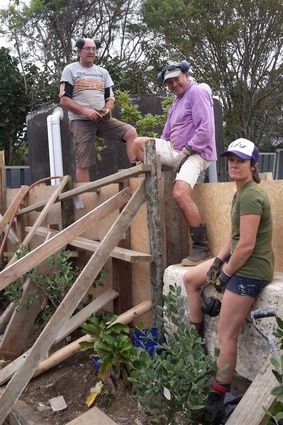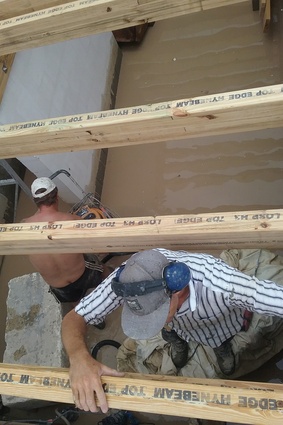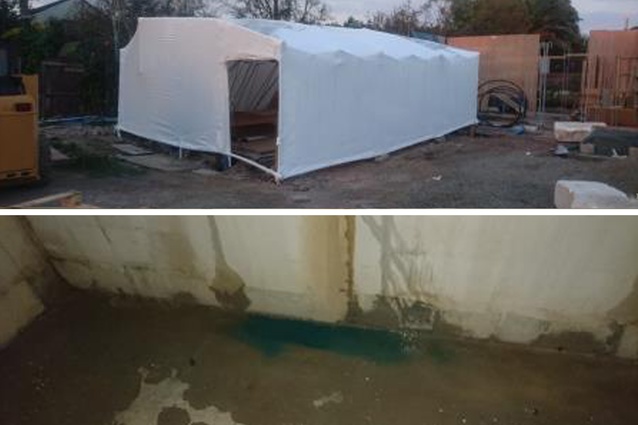The Living House: August 2018 edition
Rochelle Payne and her family are pursuing three sustainability rating standards – Homestar, Passive House and Living Building Challenge – for their new home in Beachlands, Auckland. Nearly six months on from her last update, Rochelle tell us of their basement troubles, triumphs with colourful oxides and much more.
The Bobcat got fixed in February; hallelujah, praise the Lord, we could ram again! Thankfully, Joel took advantage of this fact right away and finished ramming the walls of the playhouse. It looks amazing.
The sad news was that we had to cancel the Beer and Bangers Basement Party. The constant parade of cyclones over summer wore us down in the end, and we just couldn’t keep the basement dry enough to get the rendering done. We had to postpone until we could get the final roof on the basement and then work out if we do, in fact, have a basement leak or if all the water that kept collecting in the basement was coming from the sky. Most helpfully, many people have suggested that we turn the basement party into a pool party. Of course, we already have a pool, and it looks much nicer than the brown basement water.
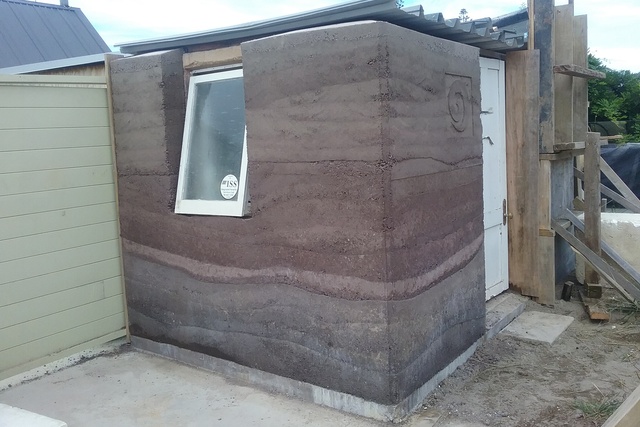
The start of March was exciting. Not for anything on site, but because I did our first radio interview on Radio Live. On site things were also exciting as our first volunteer, Stefan from Christchurch, came to stay with us for a while to learn more about building with rammed earth (he is planning to build his own house out of rammed earth eventually).
A lot of preparation work goes into building a rammed earth wall. All the foundations have to be completed, the formwork has to be built and, because we are a Passive House project, we also have to put in all the Hebel thermal breaks and made sure they are airtight – otherwise our Passive House designer, Elrond Burrell from VIA Architecture, will tell us off. It was very exciting to see all our supporters’ products lined up and ready to go into our rammed earth walls.
For those of your who don’t remember, here is how it is all put together:
- Formwork – Strandfloor by The Laminex Group
- Thermal break – AAC by CSR Hebel
- Airtightness – Tapes by Pro Clima
- Insulation – Xnergy by Forman Group
- Reinforcing – Complete Reo Services.
And the extra special rammed earth mix:
- Colour – Peter Fell Ltd
- Cement – Golden Bay Cement
- Aggregate and sand
- Special waterproofing resin (top secret agent!).
It actually took longer than anticipated to ram the first wall – two full working days. However all the boys (and nana Sandra) did a magnificent job and got it done.
We were blessed to be able to run our first proper workshop during the week of 23-27 April with the artists from the Te Hononga Kawaka Hundertwasser Park project. The purpose of this workshop was to build a new boundary fence and to experiment with different colours and textures in rammed earth. Our wonderful neighbours agreed to let us pull down the existing boundary fence and create a huge amount of noise for the entire week, even though they had a brand new baby.
It took us around two weeks to create this fence in the end. First, we had to take down the existing fence. Then, with the support of our sponsor Firth who provided the concrete, we had to pour a new footing. Lastly, we had to erect our formwork down the full 18m of fence. This time, it was a big thanks to Laminex who provided the Strandfloor. Their boards make brilliant rammed earth formwork.

We had a huge amount of fun with the Peter Fell oxides, playing with trying to create different colours. It was the first time that we had gotten to try out greens and blues. Such fun! Peter Fell even provided us with a little white cement to really allow the greens and blues to pop.
Our incredible supporter Golden Bay Cement has provided us with material for the majority of the walls, but we found that the grey cement fought with a few of the oxides, and we wanted to see what white cement would do. We had a great result! We also took the opportunity to play with some textures and threw sea glass and shells into the wall to see what would happen. The glass didn’t really turn out as hoped, but the shells looked great.
After the welcomed distraction of the wall workshop in April, we really needed to settle down and start building some walls on the house. The basement also required some attention as it was still leaking. May and June were therefore designated to be the months of progress. Did that happen?

Well, a little bit. We managed to get the attention of the waterproofing contractors and they came back to site a couple of times and did some serious work on trying to fix the leaks. However, it was not successful, and the basement still leaked water. It was starting to get serious as we were getting stagnant water sitting in the basement, causing all sorts of problems.
In more positive progress, we had a “poosher” – a visitor that comes via the website www.poosh.org – from the US, Erin Burk, stay with us in the Hundertwasser sleep out for a few weeks in June to help Joel and Max build some rammed earth walls. In July we started exposing some of our rammed earth walls that were built in June with mixed results. All of the walls look amazing in isolation, however when all put together it is a little crazy.
Some members of the Living House team are not overly excited with the wild wall colour approach but are still holding an open mind, thinking that perhaps it won’t look too bad once the roof is on and the interior walls are up. If it does … well there is a back up plan to paint the inside of the one bedroom apartment all the same colour. We don’t want to make the people who will be staying there crazy, after all.
The great news is that, right now, the basement has been getting some serious attention, and it is now entirely possible that we have managed to stop water getting in from the outside. We have used Equus Aqua Fin IC to seal the inside of the basement and hope that we can move ahead and finish rendering the basement, put the stairs in and then install cool things like the wine cellar and wall art.
We are also going to be on the Superhome Movement tour on September 29th. If you want to come and take a look at the progress of the Living House in real life, keep an eye on the Superhome Movement website for the open home times.
We’ve also had a few visitors on site again this month helping out with the rammed earth. Thank you so much Toby and Corinna (our AirBnB guests, who just happened to be really interested in what we were doing so decided to help out for a day) and Toby and Helen who also came up to work with us and learn about rammed earth.
Keep watching this space for more updates on the Living House project and visit their website here for more information. Read the introduction to the Living House here, the second update here, the third post here and the fourth post here.

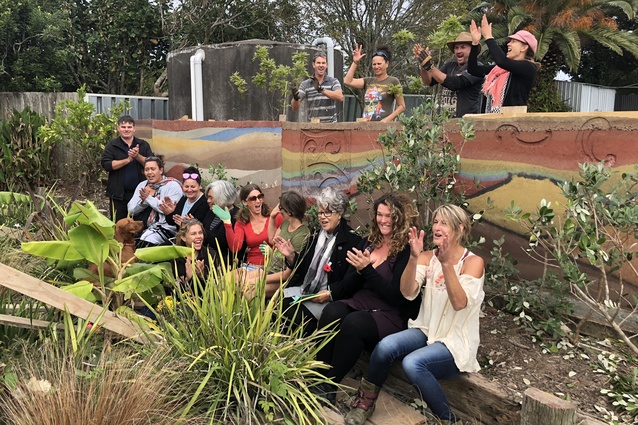
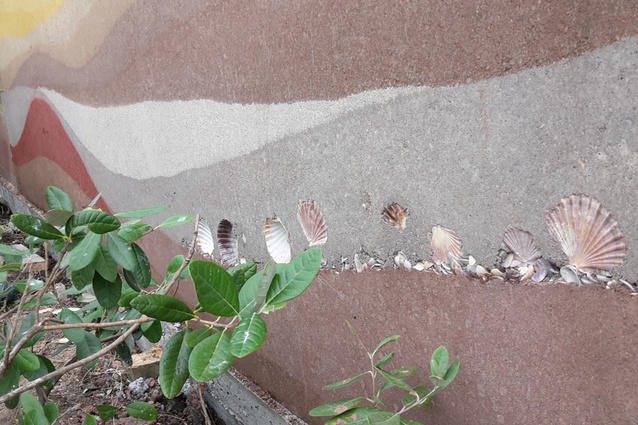
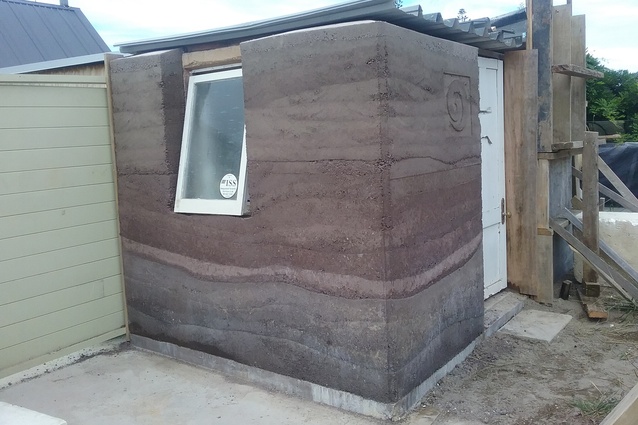
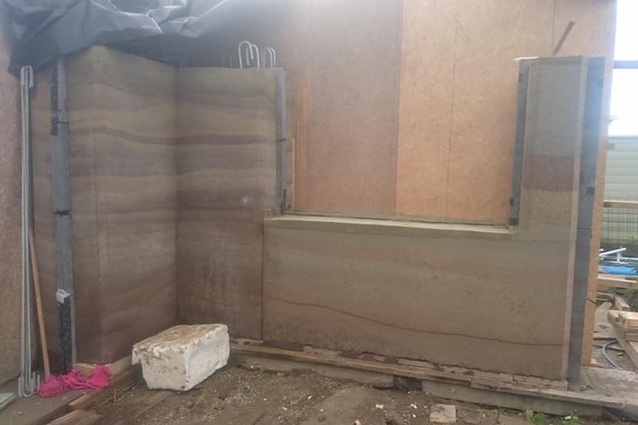
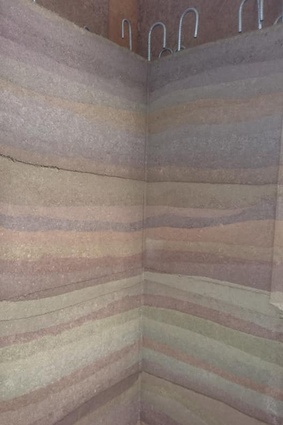
![Rochelle says they are "still holding an open mind, thinking that perhaps [the walls] won't look too bad once the roof is on and the interior walls are up".](https://cdn.architecturenow.co.nz/site_media/media/cache/ec/a4/eca4fc331060c6275cdeebee9c2fa4e8.jpg)


